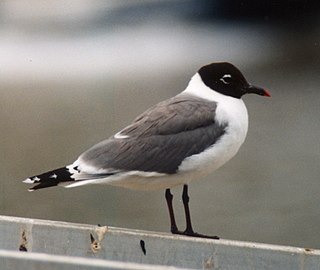
The laughing gull is a medium-sized gull of North and South America. Named for its laugh-like call, it is an opportunistic omnivore and scavenger. It breeds in large colonies mostly along the Atlantic coast of North America, the Caribbean, and northern South America. The two subspecies are L. a. megalopterus — which can be seen from southeast Canada down to Central America — and L. a. atricilla, which appears from the West Indies to the Venezuelan islands. The laughing gull was long placed in the genus Larus until its present placement in Leucophaeus, which follows the American Ornithologists' Union.

Franklin's gull is a small gull. The genus name Leucophaeus is from Ancient Greek leukos, "white", and phaios, "dusky". The specific pipixcan is a Nahuatl name for a type of gull.

The Fucales (fucoids) are an order in the brown algae. The list of families in the Fucales, as well as additional taxonomic information on algae, is publicly accessible at Algaebase.

The pygmy fruit-eating bat is a bat of the family Phyllostomidae. The specific name phaeotis is of Greek derivation, coming from the word phaios meaning dusky, referring to their dusky gray coloration.

Leucophaeus is a small genus of medium-sized New World gulls, most of which are dark in plumage, usually with white crescents above and below the eyes. They were placed in the genus Larus until recently. The genus name Leucophaeus is from Ancient Greek leukos, "white", and phaios, "dusky".
Phaio is a genus of moths in the subfamily Arctiinae.
Stygitropha is a genus of moths belonging to the subfamily Olethreutinae of the family Tortricidae.

Vaceuchelus is a genus of sea snails, marine gastropod molluscs in the family Chilodontaidae.
Phaio acquiguttata is a moth of the subfamily Arctiinae. It was described by Paul Dognin in 1909. It is found in Colombia.
Phaio albicincta is a moth of the subfamily Arctiinae. It was described by Schaus in 1896. It is found in Ecuador.
Phaio aurata is a moth of the subfamily Arctiinae. It was described by Schaus in 1892. It is found in Peru.
Phaio bacchans is a moth of the subfamily Arctiinae. It was described by Schaus in 1892. It is found in Peru.
Phaio caeruleonigra is a moth of the subfamily Arctiinae. It was described by Schaus in 1905. It is found in Peru.
Phaio cephalena is a moth of the subfamily Arctiinae. It was described by Druce in 1883. It is found in Colombia and Ecuador.
Phaio longipennis is a moth of the subfamily Arctiinae. It was described by Berthold Neumoegen in 1894. It is found on Cuba. The specific name was spelled "longipenuis" in the original 1894 description, and emended to "longipennis" in 1898; under ICZN Article 33.2.3.1 the emended spelling is to be preserved.
Phaio quadriguttata is a moth of the subfamily Arctiinae. It was described by Paul Dognin in 1909. It is found in Ecuador.
Phaio salmoni is a moth of the subfamily Arctiinae. It was described by Herbert Druce in 1883. It is found in Colombia.
Phaio stratiotes is a moth of the subfamily Arctiinae. It was described by Harrison Gray Dyar Jr. in 1914. It is found in Panama.
Phaio sylva is a moth of the subfamily Arctiinae. It was described by Schaus in 1896. It is found in Brazil.
Phaio unimacula is a moth of the subfamily Arctiinae. It was described by Rothschild in 1911. It is found in Peru.





